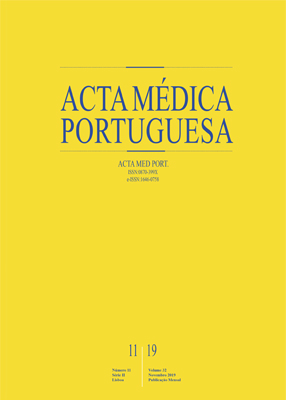Initial Assessment of the Impact of the Emergency State Lockdown Measures on the 1st Wave of the COVID-19 Epidemic in Portugal
DOI:
https://doi.org/10.20344/amp.14129Keywords:
Coronavirus Infections, COVID-19, Pandemics, Portugal, Quarantine, SARS-CoV-2Abstract
Introduction: Portugal took early action to control the COVID-19 epidemic, initiating lockdown measures on March 16th when it recorded only 62 cases of COVID-19 per million inhabitants and reported no deaths. The Portuguese public complied quickly, reducing their overall mobility by 80%. The aim of this study was to estimate the initial impact of the lockdown in Portugal in terms of the reduction of the burden on the healthcare system.
Material and Methods: We forecasted epidemic curves for: Cases, hospital inpatients (overall and in intensive care), and deaths without lockdown, assuming that the impact of containment measures would start 14 days after initial lockdown was implemented. We used exponential smoothing models for deaths, intensive care and hospitalizations and an ARIMA model for number of cases. Models were selected considering fitness to the observed data up to the 31st March 2020. We then compared observed (with intervention) and forecasted curves (without intervention).
Results: Between April 1st and April 15th, there were 146 fewer deaths (-25%), 5568 fewer cases (-23%) and, as of April 15th, there were 519 fewer intensive care inpatients (-69%) than forecasted without the lockdown. On April 15th, the number of intensive care inpatients could have reached 748, three times higher than the observed value (229) if the intervention had been delayed.
Discussion: If the lockdown had not been implemented in mid-March, Portugal intensive care capacity (528 beds) would have likely been breached during the first half of April. The lockdown seems to have been effective in reducing transmission of SARS-CoV-2, serious COVID-19 disease, and associated mortality, thus decreasing demand on health services.
Conclusion: An early lockdown allowed time for the National Health Service to mobilize resources and acquire personal protective equipment, increase testing, contact tracing and hospital and intensive care capacity and to promote broad prevention and control measures. When lifting more stringent measures, strong surveillance and communication strategies that mobilize individual prevention efforts are necessary.
Downloads
Downloads
Published
How to Cite
Issue
Section
License
All the articles published in the AMP are open access and comply with the requirements of funding agencies or academic institutions. The AMP is governed by the terms of the Creative Commons ‘Attribution – Non-Commercial Use - (CC-BY-NC)’ license, regarding the use by third parties.
It is the author’s responsibility to obtain approval for the reproduction of figures, tables, etc. from other publications.
Upon acceptance of an article for publication, the authors will be asked to complete the ICMJE “Copyright Liability and Copyright Sharing Statement “(http://www.actamedicaportuguesa.com/info/AMP-NormasPublicacao.pdf) and the “Declaration of Potential Conflicts of Interest” (http:// www.icmje.org/conflicts-of-interest). An e-mail will be sent to the corresponding author to acknowledge receipt of the manuscript.
After publication, the authors are authorised to make their articles available in repositories of their institutions of origin, as long as they always mention where they were published and according to the Creative Commons license.









